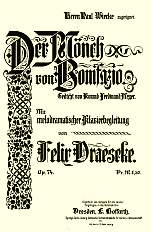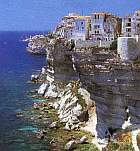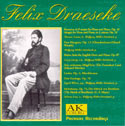|
Melodrama, Op. 74, Der Mönch von Bonifazio (The Monk of Bonifacio) (Conrad Ferdinand Meyer) |
|
Read the texts of the Melodrama Download a copy of the score to Der Mönch von Bonifazio
|
When
one is acquainted with the life and career of Felix Draeseke,
it
strikes one as ironic that the one piece for which Draeseke
was popularly known during his lifetime was Helges Treue, Op. 1
- but not in his original version for baritone and piano, but
in the arrangement as melodrama for speaker and piano by Franz
Liszt, whose enthusiasm for Draeseke's first The poetic style of Conrad Ferdinand Meyer is known for its extremely individual style and many a work of his demands careful reading, for various reasons. Draeseke's melodrama is a very gripping when presented with understanding and emotional expression. However, without knowledge of the genuine historical circumstances behind the poem, listeners or readers might encounter a certain frustration if not outright confusion or total lack of comprehension. The content of the poem concerns itself with the Genoa port of Bonifacio on the southern coast of Corsica which King Alfonso V (the Wise) of Aragon attempted to conquer in 1420. Corsica had belonged to Genoa since the end of the 13th century. |
| Melodram, Op. 74 Der Mönch von Bonifazio (Conrad Ferdinand Meyer) | |
|
|
Wenn man
mit dem Lebenslauf von Felix Draeseke vertraut ist, erscheint
es ironisch, daß das Stück, wofür
Draeseke zu Lebzeiten am besten bekannt war, seine Helges Treue,
Op. 1 war – nicht in der Urfassung für Singstimme
(Bariton) und Klavier des Komponisten, sondern in der Bearbeitung
als Melodram für Sprecher und Klavier von Franz Liszt, dessen
Begeisterung für Draesekes Erstlingsdruck zu einer sehr
effektiven Auseinandersetzung mit Draesekes Stoff führte,
aber auch zu einer drastischen Kürzung des Originals. Ob
es sich um den dramatischen Inhalt des Strachwitzschen Gedichts
oder vielleicht um den Namen Liszts oberhalb desjenigen von Draeseke
auf der Titelseite handelte,
|
| Draeseke's Der Mönch von Bonifazio on CD: | |
|
"Helmut Loos is theatrical yet controlled as the narrator in the melodrama, pacing his performance with great skill." Adagio for Horn and Piano, op. 31 (1885); Romanze for Horn and Piano, op. 32 (1885); Fata Morgana, op. 13 (1877); Kleine Suite for English Horn and Piano, op. 87 (1911); Das verlassene Mägd'lein, op. 2: Vol II nr 5; Märzblumen Lieder, op. 2: Book I; Drei Gesänge, op. 76 (1906); Der Mönch von Bonifazio, melodrama after C.F.Meyer, op. 74 Wolfgang Müller-Steinbach [piano], Thomas Crome [horn], Georg Lustig [english horn], Ingrid Würtz [soprano], Helmut Loos [narrator] |
|
[Chamber Music] [Orchestral Music] [Keyboard Music] [Top]
© All contents copyright by the International Draeseke Society


 Der
Dichterstil Conrad Ferdinand Meyers ist bekanntlich sehr individuell
and
manche seiner Werke fordern, sehr sorgfältig
gelesen zu werden, und zwar aus verschiedenen Gründen. Draesekes
Melodram ist ein sehr ergreifendes Werk, wenn es mit Ausdruck
und Verstand vorgetragen wird. Aber ohne Kenntnis der historischen
Tatsachen dahinter, mögen Leser Gefühle von Frustration,
Verwirrung oder Nichtbegreifens empfinden. Der Inhalt des Gedichts
handelt sich von dem genuesischen Hafen Bonifazio auf der Südspitze
Korsikas im Jahr 1420, als König Alfons V (der Weise) von
Aragonien ihn erobern wollte. Korsika hatte seit dem Ende des
13. Jahrhunderts der Republik Genua angehört.
Der
Dichterstil Conrad Ferdinand Meyers ist bekanntlich sehr individuell
and
manche seiner Werke fordern, sehr sorgfältig
gelesen zu werden, und zwar aus verschiedenen Gründen. Draesekes
Melodram ist ein sehr ergreifendes Werk, wenn es mit Ausdruck
und Verstand vorgetragen wird. Aber ohne Kenntnis der historischen
Tatsachen dahinter, mögen Leser Gefühle von Frustration,
Verwirrung oder Nichtbegreifens empfinden. Der Inhalt des Gedichts
handelt sich von dem genuesischen Hafen Bonifazio auf der Südspitze
Korsikas im Jahr 1420, als König Alfons V (der Weise) von
Aragonien ihn erobern wollte. Korsika hatte seit dem Ende des
13. Jahrhunderts der Republik Genua angehört.